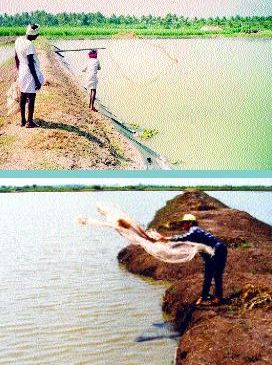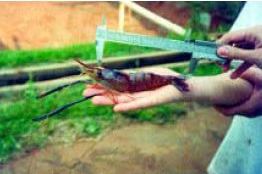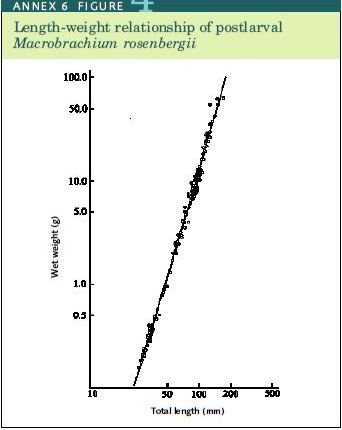6 Stock estimation
ESTIMATING OF THE NUMBER of animals present under hatchery or pond conditions is difficult. The four critical times when it is important to assess the number (and sometimes the size) of prawns present in the system are:
when postlarvae are harvested, to provide a record and an assessment of the pro duction efficiency of each larval batch and tank;
when postlarvae are transferred from the hatchery to the pond, to control stock ing density and determine feeding rates;
at intervals during the grow-out period, to check growth rate and survival; and when market-sized prawns are harvested, to provide a final or cumulative record (an assessment of the productivity of the pond and management system being used).
The following methods are suggested for stock estimation.
1. Stock estimation when postlarvae are harvested
The following system is suggested:
a) before the harvested PL are transferred to the PL holding tank, suspend them tem porarily in a small container with a known volume of aerated water;
b) agitate the water thoroughly to evenly disperse the animals;
c) take four samples from the container in 100 ml beakers;
d) now place the bulk of the postlarvae into the holding tank (do not wait until the sam ple counting process is complete);
e) count every animal in each of the four 100 ml beakers (one way of doing this is to take quantities into a graduated pipette held at a 45° angle towards a lamp and to count the animals as they swim up towards the light);
f) average the number of postlarvae found in each 100 ml beaker and multiply this number by the volume of water in the container mentioned in (a) above (in ml) and divide by 100.
The following is an example of the calculation for a postlarval stock estimation:
Let us assume that the small container [see (a) above] had a volume of 25 L. You counted 80, 86, 90 and 100 postlarvae in the four beakers [see (e) above]. The total number of post larvae in the 25 L container can be calculated as follows:
Average number of PL in 100 ml = (80 + 86 + 90 + 100) ÷ 4 = 89
Number of PL in the 25 L container = 89 x 25 x 1 000 ÷ 100 = 22 250
2. Stock estimation when postlarvae are transferred to nursery or to grow-out facilities
The following procedure is not very accurate but is sufficiently practical for use, especially where the same person always does the counting:
a) on every transfer occasion count out 100 PL individually by dipping a hand bowl into a larger bowl containing PL. Transfer them into the plastic transport bag, or the transport tank;
b) measure out further batches by visual comparison to the counted batch, and add them to the plastic bag or transport tank. You will quickly become able to estimate the number of PL in each small bowlful dipped from the larger bowl quite accu rately;
c) once the PL have been counted into the bags or transport tanks in batches, usually of 1 000 or 2 000, they are not normally counted again before they are stocking into the rearing facilities.
Another version of the method described above is to weigh the first batch counted [see (a) above] and use this weight alone to measure subsequent batches. However, this may cause more stress to the animals. Note that two-month old juveniles are much easier to count than PL.
3. Stock estimation during the grow-out period
Once the prawns have been put into a pond, it is extremely difficult to estimate growth rate or survival. Multiple seine and cast net samples seem the only reasonable method of fol lowing the growth rate of a crop of prawns. At least this enables a comparative esti mate to be made. It is important that the method of sam pling on each occasion is exactly the same (the same net; the same time of day; the same areas of the pond sampled; the same method of casting or pulling the net through the pond; and preferably the same person doing the sampling).
ANNEX 6, Figure 1 Freshwater prawns can be sampled with a cast net; the polythene sheeting is not a pond liner but is placed on the banks to prevent prawns escaping from the pond in the rainy season (India)
ANNEX 6, Figure 2 This sampling by cast net reveals a badly eroding pond bank (Thailand)

SOURCE: STEPHEN SAMPATH KUMAR (TOP) SOURCE: MICHAEL NEW (BOTTOM)
Even though the result may be grossly inaccurate, sampling animals from the ponds with a cast net (Annex 6, Figures 1 and 2) or a seine net on a regular basis does give you a reasonable idea of how your crop is growing. It is also a good opportunity to examine the health of the animals. It does not, unfortunately, give you much more than a vague idea of the survival rate.
4. Stock estimation when market-sized prawns are harvested
From the practical rather than the scientific point of view, there are two vitally important data which must be recorded at harvest time. One is the total drained weight of the harvest and the other is the average size of the animals harvested.
From these data the numbers of animals harvested can be estimated. Since you already have an estimate of the number of PL or juveniles stocked, you can then calcu late an estimated survival rate. Together, you can use these data to assess the pro ductivity of your pond and the efficiency of the management system you have used. Combined with the costs of production and the market value of the product, this information enables you to calculate the overall economic performance of each pond.
Although the length of the prawn [biologists usually measure them from behind the eye stalk to the tip of the tail (Annex 6, Figure 3); farm ers usually measure them from the tip of the rostrum to the tip of the telson] is a more accurate form of measurement than weight, it is not so easy for the you to measure, partic ularly as you then have to con vert the measurement to weight using a calibration curve (Annex 6, Figure 4).
The weight of the animal can easily be measured on a portable scale. It will be inac curate because of the amount of water adhering to the
ANNEX 6, Figure 3
Measuring the length of a prawn (Brazil)

SOURCE: DEBORAH ISMAEL
ANNEX 6 FIGURE 4
Length-weight relationship of postlarval Macrobrachium rosenbergii

SOURCE: WICKINS (1972)
animal, particularly within the gill chambers. However, especially when the same person always does the weighing, it is possible to standardize the weighing technique and to achieve reasonable comparative accuracy.
It is suggested that you individually weigh about 250 animals for every 500 kg har vested (this is equivalent to a 2% sample of the population if the average weight is 40 g). Take the sub-sample from the total harvest by dip-netting from the holding container or cage. Do not select individual animals because this will lead to a bias towards the larger animals. Use a dip-net and weigh every prawn that you obtain in your sample.